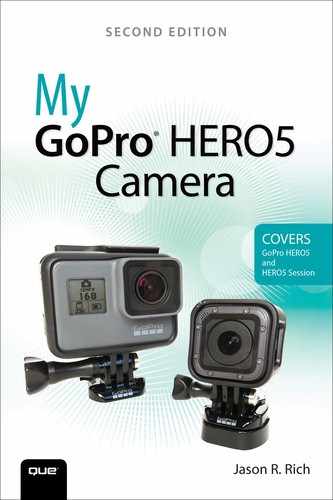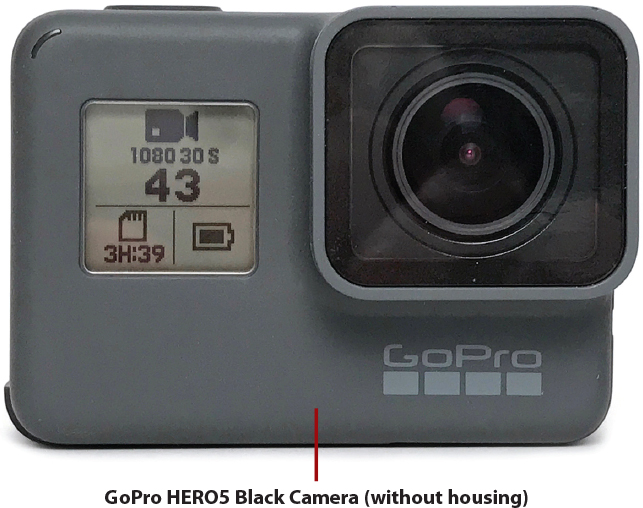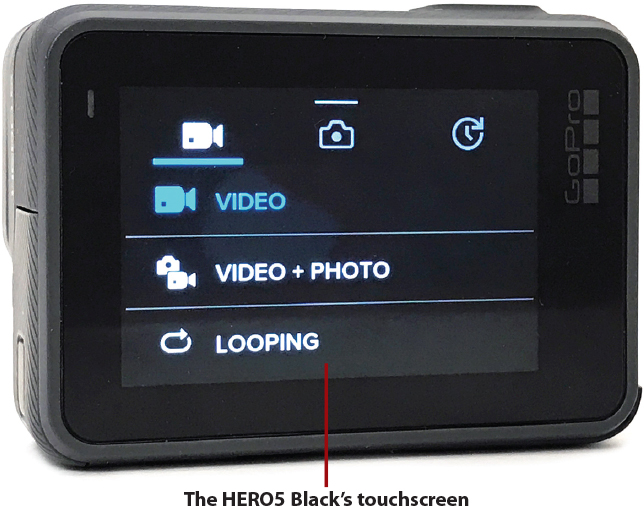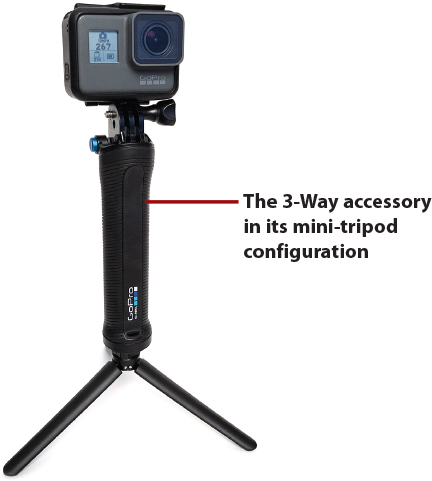01. Overview of the GoPro HERO Cameras
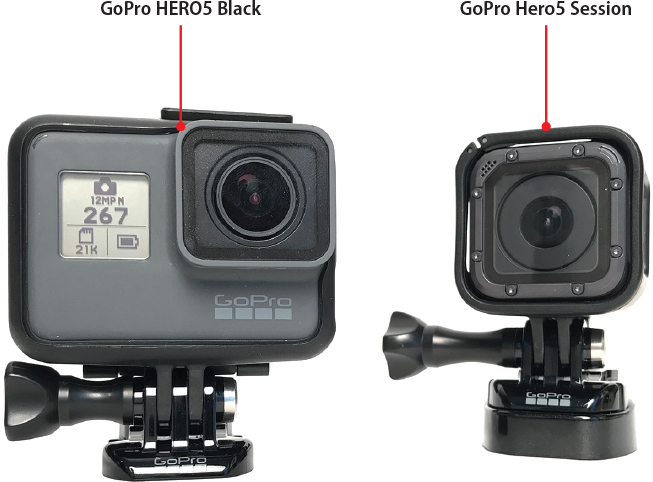
This chapter introduces you to the GoPro HERO Session, GoPro HERO5 Session, and HERO5 Black camera models. You discover what sets them apart from older GoPro camera models. Topics include the following:
![]() Find out how GoPro cameras have evolved
Find out how GoPro cameras have evolved
![]() Discover the advantages of shooting with a GoPro HERO5 series camera
Discover the advantages of shooting with a GoPro HERO5 series camera
![]() Understand the differences between camera models
Understand the differences between camera models
![]() Learn the importance of using the camera with the proper mount and accessories
Learn the importance of using the camera with the proper mount and accessories
When the very first GoPro digital camera was introduced in 2006, it changed digital photography and videography forever. This camera had a mere 10-second video recording capacity, and, at the time, it was truly revolutionary.
Well, times have changed, and technology has progressed dramatically. Today, the GoPro brand cameras offer cutting-edge digital photography and videography technology that’s packed into small, battery-powered, lightweight, extremely durable, and weather-resistant housings. Plus, literally hundreds of optional camera mounts and accessories are available (sold separately), that make these cameras extremely versatile when it comes to shooting indoors or outdoors, in almost any shooting situation—including underwater.
Using one of the relatively low cost GoPro HERO cameras, virtually anyone can capture professional-quality and visually stunning, high-resolution photos and/or HD video. Best of all, the photographer/videographer never needs to worry too much about damaging his equipment when shooting in dry, wet, hot, cold, or extremely harsh conditions, as the GoPro cameras are incredibly durable.
The primary focus of My GoPro HERO5 Camera is on the HERO5 Black and HERO5 Session camera models; however, much of the information offered within this book also applies to the lower-end HERO Session camera.
Thanks to the ultra-small size of the GoPro HERO cameras and the vast selection of optional mounts available for them, these cameras can be securely attached directly onto someone’s body or equipment, which makes it possible to capture action from a first- or third-person perspective. This feature alone has transformed the way people capture and share their action or adventure-oriented experiences.
With a GoPro camera mounted on yourself or your equipment, you can capture awesome, high-resolution digital images or stunning HD video footage by adjusting the settings directly on the camera, and then simply pressing the Shutter button. However, thanks to the wireless capabilities of the HERO cameras, you can remotely control the camera from up to several hundred feet away via the GoPro Capture mobile app that’s available for iOS and Android smartphones, tablets, and smart watches.
Speak Up!
One new feature of the GoPro HERO5 Session and HERO5 Black is the ability to control these two cameras using voice commands, so there’s no longer a need to fumble with menu options and camera buttons when operating the camera, especially while you’re engaged in action-oriented activities that require you to keep your hands free.
The GoPro HERO camera makes it easy and fun to capture photos or video, whether you’re a proud parent who wants to document moments in your family’s life, capture and share the antics of your pet from a unique perspective, chronicle your travels, or shoot photos or video of yourself engaged in intense activities—such as skateboarding, skiing, snowboarding, surfing, snorkeling, or scuba diving to name just a few. However, simply capturing photos and video content is only the beginning. GoPro also offers extremely powerful and versatile tools that enable you to edit images and video content on a smartphone, tablet, or computer, view them on the highest-resolution TVs and monitors, and easily share them online.
An Entirely New Shooting Experience
Even if you’re a veteran GoPro HERO camera user, when you upgrade to one of the latest camera models, you can expect a vastly improved and more intuitive experience for shooting, editing, viewing, and sharing your content.
The operating system (Camera Software) that controls these latest camera models has been redesigned from scratch. The accessories, mobile apps, and computer software designed for use with the GoPro cameras have also been revamped to provide cutting-edge tools that enable you to capture and produce photos and video that showcase vivid colors, extreme detail, steadier video, clearer sound, and content that rivals what’s possible using professional-level equipment that costs thousands of dollars.
Think of digital photography and videography as both a skill and an art form. The technology that’s built into today’s digital cameras, including the GoPro HERO cameras, is equivalent to what you’d find in a computer. Like a computer, a GoPro camera has an operating system, processor, digital storage, menus to navigate, buttons to push, and commands to learn.
Thus, learning how to properly use your GoPro HERO camera requires skill. After all, you need to know which features and functions to use, when to adjust the camera’s settings and options, and how to operate the camera. The camera offers dozens of shooting modes, features, and settings that are designed to help you capture the best content possible.
In addition to knowing how to use the camera, becoming a skilled digital photographer or videographer requires creativity. The art aspect of digital photography/videography involves choosing what to shoot, when to shoot, and how to best frame your shots. For example, after you’ve selected your intended subject, it’s necessary to determine the best shooting angle or perspective from which to position the camera and how to best utilize light based on your current shooting situation. If you’re shooting video, you also need to consider sound quality.
Many amateur photographers and videographers simply hold the camera in their hands, center their subject within the viewfinder, and then shoot their subject from a head-on perspective. In other words, they use a boring approach. To capture content that’s visually interesting and artistic, you need to make some creative and subjective decisions. Then, after you’ve shot your images and/or video, you need to make additional creative decisions while you’re editing.
Understanding Digital Camera Resolution
The quality of photos you’re able to take using any digital camera depends directly on its resolution, which is measured in megapixels (MP). The more megapixels used to capture an image, the more detail and color vibrancy you see within the image.
Higher resolutions translate directly to larger digital file sizes, so when it comes to storing images on the camera’s memory card, or later on your computer’s hard drive, higher resolution images require more storage space.
The term high-definition video (or HD video) is thrown around a lot these days, and most people assume that as long as a camera is capable of shooting HD video, the video footage they shoot is automatically the highest quality possible. Unfortunately, things aren’t that simple.
There are several industry-standard HD resolutions, including 720p, 1080p, 2.7K, and 4K. Video resolution is also measured in pixels, or individual colored-dots that together form a single frame within your video footage.
For example, video shot at 720p utilizes a frame size of 1,280 × 720 pixels, so each frame is comprised of 921,600 individual pixels. Meanwhile, video shot at Ultra HD (4K) resolution is typically 4096 × 2160 pixels per frame. The following graphic offers a visual comparison that will help you understand HD video resolution.
The higher the resolution, the more vibrant and detailed your video footage will be because a lot more information is captured within each frame. In addition, your field of view when shooting in HD or Ultra HD can be much wider.
Depending on how you plan to edit and showcase your HD or Ultra HD video footage, you need to consider how many frames per second (FPS) you need to shoot. Typically, HD video is shot at 24 or 30 FPS. However, the higher the FPS, the more editing versatility you have—for example, when it comes to playing your footage in ultra-slow motion. With the GoPro HERO5 Black, you can shoot at 4K resolution at up to 30 FPS, but you can shoot at 1080p resolution at up to 120 FPS.
Another thing to consider when it comes to shooting HD video is your field of video (FOV). All HD television sets, for example, display a rectangular-shaped video image. How much is visible to the sides of your shots when the camera is facing forward is what FOV refers to. For example, the GoPro HERO5 Black camera can shoot at 1080p using a Narrow, Linear, Medium, Wide, or Superview FOV.
When you combine these three factors—resolution, FPS, and FOV—there are literally dozens of possible combinations for capturing your HD video. Shooting at 30 FPS and 4K resolution using a Superview FOV doesn’t always make the most sense, nor is it the most practical combination. The higher the resolution, FPS, and FOV you choose, the larger your digital video file sizes will be. To capture video at 30 FPS, 4K resolution, using a Superview FOV, for example, you need a microSD memory card with high storage capacity to store your raw footage. Then, you need a computer with a large capacity hard drive, plenty of RAM, a fast processor, and a 4K-compatible display to later view and edit the footage.
More about video resolution, FPS, and FOV is covered later in this book, but for now, it’s important to understand that the GoPro HERO Session, HERO5 Session, and HERO5 Black camera models offer a different selection of video shooting options.
Choosing the Right GoPro Camera
GoPro offers three GoPro camera models in its current lineup:
• The lower-end, cube-shaped, and least expensive GoPro HERO Session
• The mid-priced, cube-shaped, GoPro HERO5 Session
• The high-end GoPro HERO5 Black
While older GoPro models, such as the HERO3+ or HERO4 Black, may still be available on the secondary market, they’re no longer being sold directly by GoPro. Depending on your budget, as well as how and where you’d ultimately like to use your camera, it’s essential that you select the right GoPro camera model to meet your needs. This is particularly important when it comes to shooting high-definition (HD) video. Table 1.1 helps you easily compare the three current GoPro HERO camera models based on the key features and functions each offers.
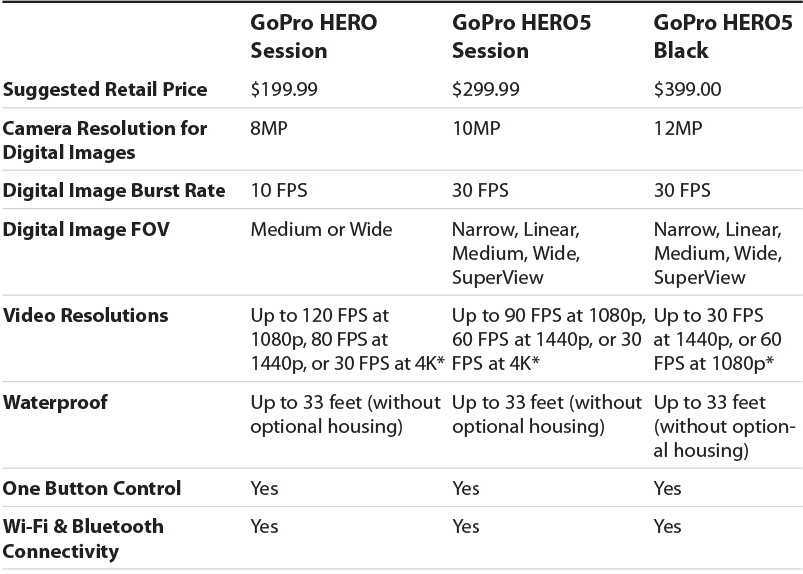
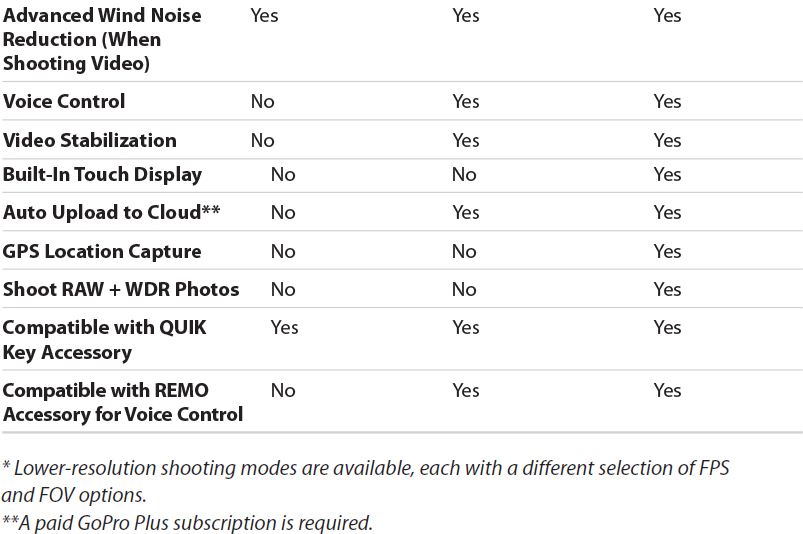
Table 1.1 At-A-Glace GoPro Camera Comparison
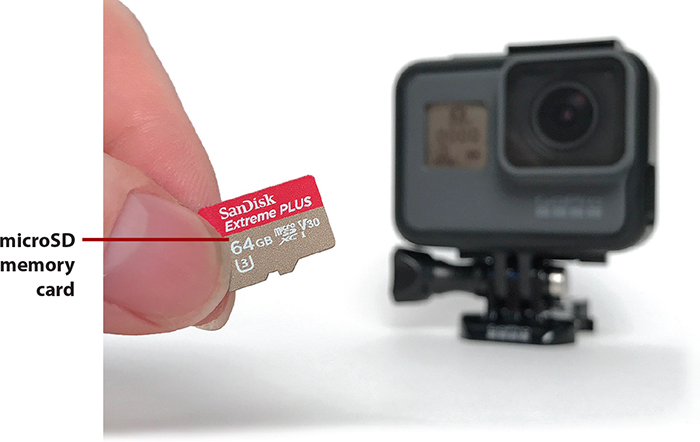
One thing that’s not included with any GoPro camera but is needed to use it is a microSD memory card. See Chapter 6, “Choosing the Best Memory Cards,” for more information about choosing the best memory card(s) to meet your needs.
The GoPro HERO Session
Priced at $199.99, the cube-shaped GoPro HERO Session offers the fewest options when it comes to shooting digital images or HD video. In every sense of the word, this is a “consumer-oriented” camera.
This camera model is waterproof (up to 33 feet), shock-resistant, and highly durable, so it can be used in a wide range of shooting situations. For example, you can hold the camera and shoot a subject that’s in front of you, or shoot from a first- or third-person perspective.
In terms of video, the entry-level GoPro HERO Session can shoot at up to 1440p resolution and offers far fewer FPS and FOV options than more advanced models. Other drawbacks to this camera model are that it doesn’t offer video stabilization, voice control, or a built-in touch screen.
Although you can use the two buttons and the small Status Screen to control the camera, you’ll probably prefer to use the optional Smart Remote or wirelessly link the camera to your smartphone or tablet (and use the Capture app) to adjust its settings and control many of its features remotely.
When you want to transfer content from the camera’s microSD memory card, you need to either remove the card from the camera and insert it into a memory card reader that’s connected to your computer or mobile device or connect a USB cable between your camera and computer or mobile device. You can also use the optional QUIK Key accessory, which is a tiny memory card reader that connects directly to the Lighting port (on an iOS device), the Micro USB port of other mobile devices (including Android smartphones or tablets), or a USB-C port of a computer (depending on which model QUIK Key you choose).
On the plus side, the GoPro HERO Session has a wide range of mounts and accessories available for it, so you can use it in a wide range of shooting situations, although it’s not as versatile as the more advanced (and expensive) GoPro HERO5 Session and HERO5 Black camera models.
The GoPro HERO5 Session
Like the GoPro HERO Session, the GoPro HERO5 Session is a tiny, cube-shaped camera that offers a slightly less expensive option than the top-of-the-line HERO5 Black. What the HERO5 Session camera lacks is a built-in, full-color touchscreen; GPS (used to capture the exact location where you shoot); and some of the shooting modes and resolution, FPS, and FOV options that are offered by the HERO5 Black.
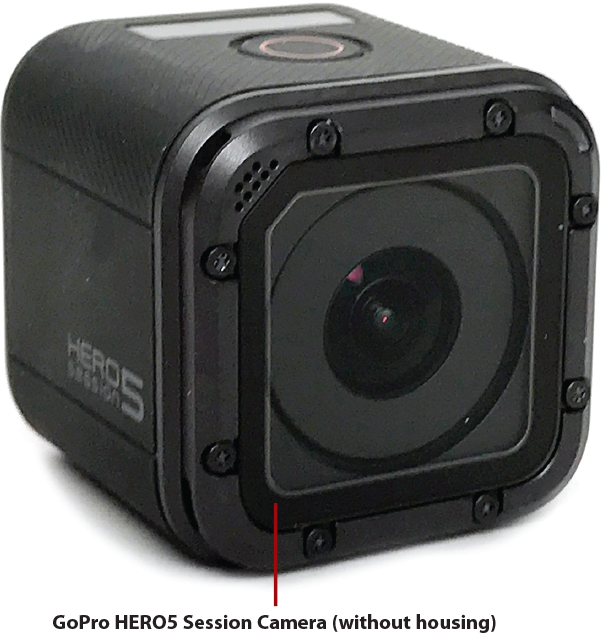
As a digital camera, the HERO5 Session shoots at up to 10MP resolution. It offers a burst shooting mode and time lapse shooting mode that can be used for taking still digital images.
The GoPro HERO5 Session is ideal for adventure enthusiasts who want to capture high-resolution photos and videos while engaged in many types of activities. The tiny, cube-shaped design of this camera makes it extremely portable, or attachable in a variety of ways to a person, object, or piece of equipment.
This camera offers a plethora of other useful features and functions that make it versatile, but you’ll probably want to use voice controls, the optional Smart Remote, or link the camera wirelessly with a smartphone or tablet to adjust its shooting mode, shooting resolution, as well as control other related features and functions.
The GoPro HERO5 Black
The GoPro HERO5 Black camera offers 12MP resolution when shooting still images, and like the GoPro HERO5 Session it offers both burst and time-lapse shooting modes. It also offers the ability to capture Ultra HD video (4K resolution), which is typically the highest resolution that consumer-oriented television sets and computer monitors can display (although in 2017, 8K resolution TVs and monitors are becoming available).
The GoPro HERO5 Black has shooting modes that work particularly well in low-light or at night. For some, the camera’s ability to shoot video and capture digital photos at the same time is also a useful feature, as are the automatic video stabilization option and the ability of the camera to automatically upload photos and video to the cloud. (A paid subscription to GoPro Plus is required, and the camera must be within the signal radius of a Wi-Fi hotspot generated by a smartphone or tablet. Read more in Chapter 16.) Some of these features are also built into the HERO5 Session but not the HERO Session.
This top-of-the-line GoPro camera model is best suited to serious digital photography/videography enthusiasts and professionals, as well as to hard-core adventure seekers who want to capture every aspect of their activities in extreme detail, regardless of the shooting conditions.
One of the most useful features of this camera is its built-in touch display, which enables you to easily select and adjust shooting modes and related settings and use the display as a viewfinder while actually shooting. The same display also allows you to view or play back your content after shooting.
Getting the Best Results with a Mount
The GoPro cameras are small, lightweight, and can easily fit in the palm of your hand. Whether you’re shooting photos or video, it’s essential that you keep the camera as steady as possible (avoid shaking), even if you’re engaged in a high-action or fast-paced activity.
If you try holding the camera in your hands as you shoot, the camera becomes susceptible to the shaking and movement of your hands. Even if you are able to avoid too much excessive shaking, your fingers often get in the way of the lens, and they wind up getting in your shots. Plus, chances are that you’ll need your hands for whatever activity you’re engaged in, so you won’t be able to properly hold the camera.
Chapter 4, “Overview of GoPro Hero Mounts,” explains that there are literally dozens of optional and very specialized camera mounts available from GoPro and third-party companies. These mounts allow you to connect the camera to a traditional tripod, monopod, your body, or all sorts of special equipment. For example, there are optional mounts (sold separately) that allow you to attach a GoPro camera directly to your hat, safety helmet, chest, wrist, surfboard, skis, skateboard, bicycle, rifle/gun, musical instrument, vehicle, scuba/snorkeling mask, or even your dog. There are also extension arms, flexible tripods, handheld grips, and other mounts that give you more versatility for your shooting perspective.
On its own, the GoPro camera doesn’t float, although with the proper accessory (known as the Floaty, $19.99) it will. However, when swimming, waterskiing, surfing, snorkeling or scuba diving, for example, you’ll definitely want to securely attach the camera to an optional accessory, such as The Handler ($29.99), which serves as both a handle and floatation device. Another accessory that’s good for scuba diving or snorkeling is one of Octomask’s dive masks (www.octomask.com) to which you can securely attach the camera.
The popular 3-Way accessory ($69.99), which is shown here, can be configured to be a GoPro handle (camera grip), mini-tripod, or an adjustable selfie stick (extension arm).
Using GoPro Accessories
Beyond securely mounting the camera to your body or specialized equipment, for example, there are a variety of optional accessories available for the GoPro cameras that further expand its capabilities.
The GoPro Mobile Apps
If you’re a smartphone or tablet user, the free GoPro Capture and QUIK mobile apps enable you to remotely (wirelessly) control your compatible GoPro camera from your mobile device and then view and play back your content, edit it, and share it with others via the Internet.
iPhone and iPad users can download and install these two apps from the App Store, and Android smartphone and tablet users can download and install these apps from the Google Play App Store.
If you’re an Apple Watch user, the iOS edition of the Capture app allows you to remotely control your compatible GoPro camera directly from the watch (plus use the watch as a viewfinder). Read Chapter 15 for more information.
Shown here is the Capture app running on an iPhone. The GoPro is set up to shoot photos (in Photo mode) at 12MP resolution, and the HERO5 Black’s GPS feature is turned on.
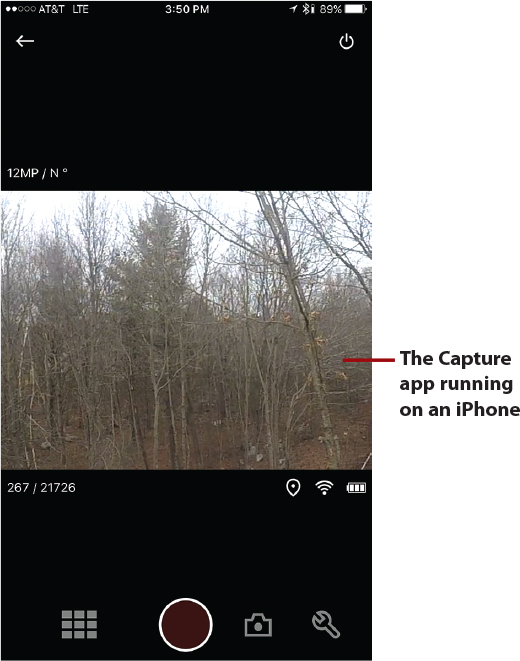
After your photos are transferred to your mobile device, you can use a third-party app to enhance or edit the images and then share them via Facebook, Instagram, Twitter, SnapChat, email, and so on. You can also use the QUIK video-editing app or a third-party video-editing app on your mobile device to edit your raw video footage and then upload it to an online service such as YouTube or Facebook without needing a computer.
The GoPro QUIK Desktop Software
When it comes to editing your HD video content on your desktop or notebook computer, the free GoPro QUIK Desktop software for PCs and Macs offers a powerful, yet surprisingly easy-to-use toolkit for viewing, editing, organizing, and sharing video.
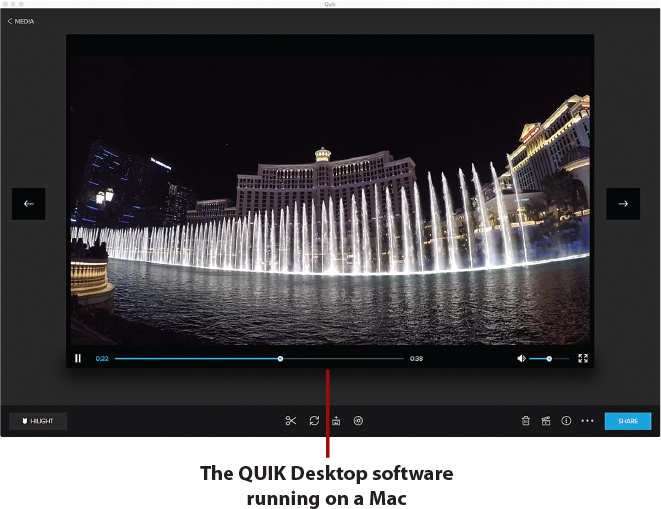
Using this software, it’s possible to create slick-looking videos with a few clicks, and then add titles, animated scene transitions, sound effects, and background music to your video production, for example. How to use this software is covered in Chapter 14.
There are also third-party video-editing software packages for PCs and Macs, such as Apple’s iMovie for the Mac, that allow you to import your raw video that was shot using a GoPro camera and then edit and share your content.
Chapter 16 explains how to use a paid GoPro Plus subscription to securely store all of your photos and video content online (in the cloud) so that you can easily access them from all of your computers and mobile devices with ease. You can also opt to share specific photos or videos with specific people, or publish them to your favorite social media/video streaming services.
Start Gathering Your GoPro Equipment
As you begin to gather together everything you need to shoot professional-quality photos and/or video using your GoPro camera in specific shooting situations, use the following checklist to insure you have everything needed at your disposal:
• A GoPro HERO Session, HERO5 Session, or HERO5 Black camera
• The Frame housing (or another optional housing) that’s used to connect your camera to an optional mount
• The optional Super Suit housing for the HERO5 Black, if you’ll be shooting underwater at depths greater than 33 feet
• An appropriate camera mount for the shooting situation at hand
• Camera accessories, such as the Remo for voice control, the Smart Remote, lens filters (for underwater shooting), or the Seeker (which is a backpack with a built in GoPro camera mount on the straps)
• One or more microSD memory cards with ample storage space available
• At least one or two fully charged GoPro camera batteries (if you’re using a HERO5 Black)
• A solution for charging the camera’s battery while on the go
• An external microphone and the optional Pro 3.5mm Mic Adapter, used for capturing better quality sound with your videos
• External lighting (if applicable)
• Your smartphone or tablet, with the GoPro Capture and QUIK mobile apps installed, or the GoPro Smart Remote accessory
